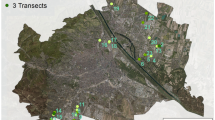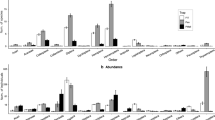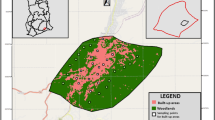Abstract
Arthropods were sampled using pitfall traps, sticky traps, sweep netting, Malaise traps and visual sampling at a national botanic garden, KwaZulu-Natal, South Africa, where the taxonomic impediment is great. The aims were to compare two sites, one of native vegetation and the other of mainly exotic plants, to determine the possible localized extent of biodiversity change across the land mosaic, and to test and compare methodologies and indicator taxa and to make recommendations for ecological landscaping of a botanic garden. Species richness and evenness varied considerably with sampling technique used. From results of a single replicate of data from all trapping methods including 821 arthropod species and 3831 individuals, a number of conclusions could be drawn. Trapping procedures such as sweep netting and pitfall traps, which focus on species with restricted mobility and/or host plant requirements, indicated greatest differences in diversity between two closely located sites. Taxa varied in sensitivity to microlandscape, again depending on the extent of their mobility. Cicindelid and carabid beetles were particularly good indicators of habitat disturbance and type. The management recommendations are that in a species-rich urban botanic garden such as this, as many ecotopes as possible should be preserved or created. These should vary in topography, landscape characteristics and vegetation composition, with as much connectivity as possible. This is a feasible blanket approach to give home to a large number of nameless species and morphs. Patches of different ecotopes should not be separated by more than a few metres by expanses of mown lawn which isolates much of the fauna.
Similar content being viewed by others
References
Anon. (1996) How the cities grow. People & Planet 5/2, 9.
Armstrong, A.J. and van Hensbergen, H.J. (1997) Evaluation of afforestable montane grasslands for wildlife conservation in the north-eastern Cape, South Africa. Biol. Conserv. 81, 179–90.
Davis, B.N.K. (1978) Urbanization and the diversity of insects. In Diversity of Insect Faunas(L.A. Mound and N. Waloff, eds) pp. 126–38. Oxford: Blackwell.
Davis, B.N.K. (1979) The ground arthropods of London gardens. London Nat. 58, 15–24.
Dawe, G. and McGlashon, S. (1987) The ecology of urban hoverflies in relation to spontaneous and managed vegetation. Brit. Ecol. Soc. Bull. 8, 168–71.
Disney, R.H.L. (1986) Assessments using invertebrates: posing the problem. In Wildlife Conservation Evaluation(M.B. Usher, ed.) pp. 271–93. London: Chapman and Hall.
Erwin, T.L. (1982) Tropical forests: their richness in Coleoptera and other arthropod species. Coleop. Bull. 36, 74–5.
Forman, R.T.T. (1995) Land MosaicsCambridge: Cambridge University Press.
Gilbert, O.L. (1989) The Ecology of Urban Habitats. London: Chapman and Hall.
Kirby, P. (1992) Habitat Management for Invertebrates: A Practical Handbook. Sandy, UK: RSPB.
Ludwig, J.A. and Reynolds, J.F. (1988) Statistical Ecology: A Primer on Methods and Computing. New York: Wiley.
Majer, J.D. (1978) An improved pitfall trap for sampling ants and other epigaeic invertebrates. J. Austr. Ent. Soc. 17, 261–2.
McGeoch, M.A. and Samways, M.J. (1991) Dragonflies (Odonata: Anisoptera) and the thermal landscape: implications for their conservation. Odonatologica 20, 303–20.
Niemela, J., Spence, J.R., Langor, D., Haila, Y. and Tukia, H. (1993) Logging and boreal ground-beetle assemblages on two continents: implications for conservation. In Perspectives on Insect Conservation(K.J. Gaston, T.R. New and M.J. Samways, eds) pp. 29–50. Andover, U.K: Intercept.
Owen, J. (1991) The Ecology of a Garden. Cambridge University Press, Cambridge.
Pearson, D.L. and Cassola, F. (1992) World-wide species richness patterns of tiger beetles (Coleoptera: Cicindelidae): Indicator taxon for biodiversity and conservation studies. Conserv. Biol. 6, 376–91.
Picker, M.D. and Samways, M.J. (1996) Faunal diversity and endemicity of the Cape Peninsula–a first assessment. Biodivers. Conserv. 5, 591–606.
Pimentel, D., Stachow, U., Takacs, D.A., Brubaker, H.W., Dumas, A.R., Meany, J.J., O’Neil, J.A.S., Onsi, D.E. and Corzilius, D.B. (1992) Conserving biological diversity in agricultural/forestry systems. BioScience 42, 354–62.
Platnick, N.I. (1991) Patterns of biodiversity: tropical v temperate. J. Nat. Hist. 25, 1083–8.
Samways, M.J. (1984) A practical comparison of diversity indices based on a series of small agricultural ant communities. Phytophylactica 16, 275–78.
Samways, M.J. (1996) Insects in the urban environment: Pest pressures versus conservation concern. In Proceedings of the 2nd International Conference on Insect Pests in the Urban Environment(K.B. Wildey, ed.) pp. 129–33. Edinburgh: International Conference on Insect Pests in the Urban Environment.
Samways, M.J. (1997) Conservation biology of Orthoptera. In The Bionomics of Grasshoppers, Katydids and their Kin (S.K. Gangwere, M.C. Muralirangan and M. Muralirangan, eds) pp. 481–96. Wallingford, UK: CAB International.
Samways, M.J. and Sergeev, M.G. (1997) Orthoptera and landscape change. In The Bionomics of Grasshoppers, Katydids and their Kin(S.K. Gangwere, M.C. Muralirangan and M. Muralirangan, eds), pp. 147–62. Wallingford, UK: CAB International.
Stork, N.E. (ed.) (1990) The Role of Ground Beetles in Ecological and Environmental Studies. Andover, UK: Intercept.
Vickery, M.L. (1995) Gardens: the neglected habitat. In The Ecology and Conservation of Butterflies(A.S. Pullin, ed.) pp. 123–34. London: Chapman and Hall.
Vogler, A.P. and DeSalle, R. (1994) Diagnosing units of conservation management. Conserv. Biol. 8, 354–63.
Williams, K.S. (1993) Use of terrestrial arthropods to evaluate restored riparian woodlands. Restor. Ecol. 1, 107–16.
Wolda, H. and Wong, M. (1988) Tropical insect diversity and seasonality. Sweep samples vs light traps. Proc. K. ned. Akad. Wet. 91, 203–16.
Wood, P.A. and Samways, M.J. (1991) Landscape element pattern and continuity of butterfly flight paths in an ecologically landscaped botanic garden, Natal, South Africa. Biol. Conserv. 58, 149–66.
Author information
Authors and Affiliations
Rights and permissions
About this article
Cite this article
Clark , T., Samways , M. Sampling arthropod diversity for urban ecological landscaping in a species-rich southern hemisphere botanic garden. Journal of Insect Conservation 1, 221–234 (1997). https://doi.org/10.1023/A:1018472118513
Issue Date:
DOI: https://doi.org/10.1023/A:1018472118513




